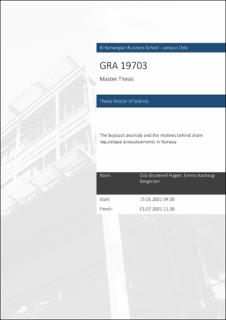The buyback anomaly and the motives behind share repurchase announcements in Norway
Master thesis
Permanent lenke
https://hdl.handle.net/11250/2826220Utgivelsesdato
2021Metadata
Vis full innførselSamlinger
- Master of Science [1621]
Sammendrag
Firms announcing a repurchase of their shares often experience a period of
abnormal returns; this is known as the buyback anomaly. The buyback anomaly is
a persistent market anomaly that is challenging to explain (Andreou et al., 2018).
Researchers like Ikenberry et al. (1995) and Peyer and Vermaelen (2009) found
positive long-run abnormal returns for firms in the 48 months following share
repurchase announcements.
This thesis is twofold. First, we investigate if Norwegian firms listed on Oslo
Stock Exchange (OSE) from 2000-2019 experience abnormal returns following a
share repurchase announcement. We employ a cross-sectional regression model
using the three-factor model by Fama and French (1993) with the additional
momentum factor (Carhart, 1997). We found long-term abnormal returns in the
four years following the repurchase announcements. Our results suggest that
Norwegian firms use share repurchase announcements to signal undervaluation to
the market, and that the market is underreacting to the undervaluation signal. The
underreaction might be rational, as several researchers claim that a repurchase
announcement is a weak signal as it does not impose any cost for the firm.
Second, we investigate what motivates these firms to announce share repurchases.
To examine the motives behind announcing share repurchases, we test the capital
structure adjustment hypothesis, the substitution of cash dividends hypothesis, the
excess cash distribution hypothesis and the signalling hypothesis. Our empirical
findings suggest that Norwegian firms announce share repurchases to signal the
market, to distribute excess cash, or to substitute cash dividends. However, it is
important to note that to substitute cash dividends or to distribute excess cash, the
firm would have to execute the repurchase after the announcement.
Beskrivelse
Masteroppgave(MSc) in Master of Science in Business, Accounting and Business Control - Handelshøyskolen BI, 2021
